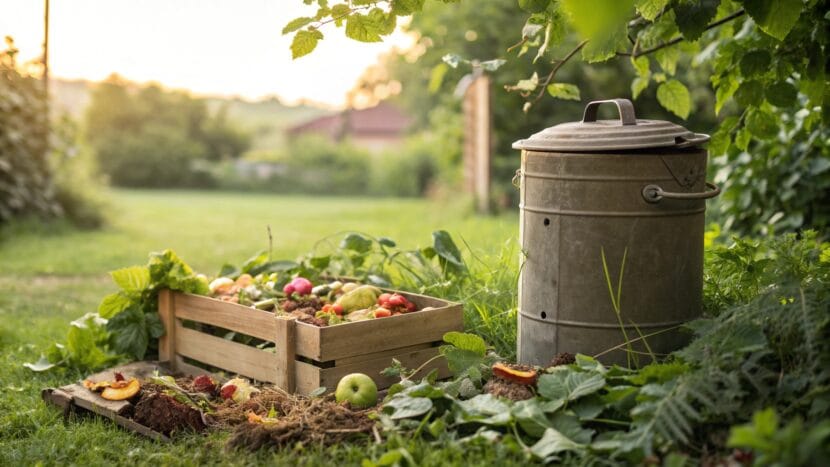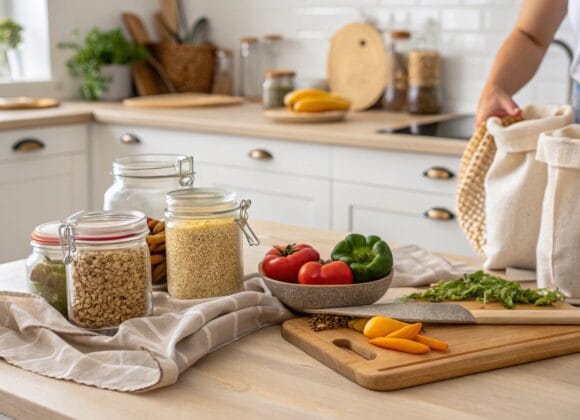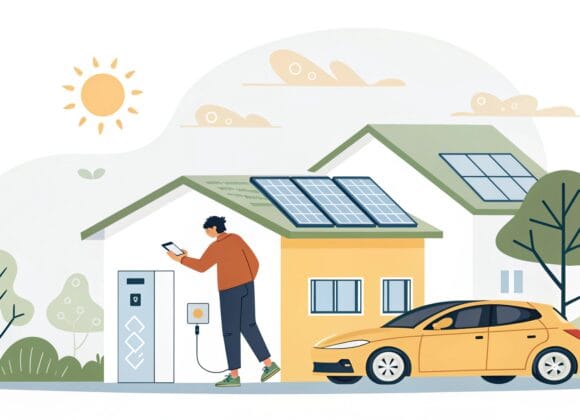Starting your composting journey might feel overwhelming at first, but composting at home for beginners is actually much simpler than you think! Whether you have a sprawling backyard or just a small apartment balcony, you can turn your kitchen scraps and yard waste into nutrient-rich “black gold” for your plants. This beginner-friendly guide will walk you through everything you need to know to start composting successfully, save money on fertilizer, and reduce your household waste by up to 30%.
Composting is essentially nature’s recycling system – and once you understand the basics, you’ll wonder why you waited so long to start. Let’s dive into this rewarding journey that benefits both your garden and the environment.
Table of Contents
What Is Composting and Why Should You Start?
Composting is the natural process of decomposition that transforms organic waste into a dark, crumbly soil amendment called compost. When you create the right conditions, beneficial microorganisms break down materials like fruit peels, coffee grounds, and fallen leaves into nutrient-rich humus that plants absolutely love.
The benefits of composting extend far beyond just creating fertilizer. You’ll dramatically reduce the amount of waste your household sends to landfills, where organic matter produces harmful methane gas. Instead, you’re creating something valuable that improves soil structure, retains moisture, and slowly releases nutrients to feed your plants throughout the growing season.
Many beginners worry that composting is complicated or messy, but the truth is that nature does most of the work for you. Your job is simply to provide the right ingredients and conditions – think of yourself as a chef preparing a recipe for beneficial bacteria and fungi.
Understanding the Science: What Makes Compost Work
Before we jump into how to start composting, it’s helpful to understand the simple science behind the process. Successful composting relies on four key elements that work together harmoniously.
First, you need the right balance of carbon-rich “brown” materials and nitrogen-rich “green” materials. Browns include items like dried leaves, newspaper, and cardboard, while greens encompass kitchen scraps like vegetable peels, coffee grounds, and fresh grass clippings. The ideal ratio is roughly 3 parts brown to 1 part green, though don’t stress about being perfectly precise.
Second, your compost pile needs adequate moisture – it should feel like a wrung-out sponge. Too dry, and decomposition slows to a crawl. Too wet, and you’ll create anaerobic conditions that produce unpleasant odors instead of rich compost.
Third, oxygen is crucial for the beneficial aerobic bacteria that do the heavy lifting in your pile. Regular turning or mixing introduces air and prevents the smelly anaerobic decomposition that gives composting a bad reputation.
Finally, temperature plays a vital role. A well-managed compost pile will heat up naturally as microorganisms work, reaching temperatures between 130-160°F in the center. This heat helps break down materials faster and kills potential pathogens and weed seeds.
Getting Started: Choosing Your Composting Method
The beauty of composting at home for beginners is that you have multiple options to choose from, depending on your space, budget, and lifestyle. Each method has its advantages, so pick the one that fits your situation best.
Traditional Compost Bins are perfect for most homeowners with yard space. You can purchase a ready-made bin or build one from pallets, chicken wire, or lumber. These contained systems keep your compost tidy while providing good airflow and easy access for turning.
Tumbler Composters offer convenience and faster results. These rotating drums make turning effortless and often produce finished compost in 6-8 weeks instead of several months. They’re ideal for people who want a neat, efficient system and don’t mind investing a bit more upfront.
Simple Pile Composting costs nothing and works wonderfully if you have space and don’t mind a more rustic approach. Just designate an area in your yard and start building your pile – many seasoned composters swear by this back-to-basics method.
Indoor Composting Options work great for apartment dwellers or those with limited outdoor space. Vermicomposting (worm composting) thrives indoors and produces exceptional compost, while electric composters can process kitchen scraps right on your countertop.
Essential Kitchen Scraps for Compost: What to Include
Understanding which kitchen scraps for compost will supercharge your pile is crucial for success. The good news is that most of what you typically throw away can actually become valuable compost ingredients.
Fruit and vegetable scraps form the backbone of most home compost piles. Apple cores, banana peels, citrus rinds, potato skins, lettuce leaves, and carrot tops all decompose beautifully. Don’t worry about removing stickers from produce – they’ll either decompose or can be easily picked out of finished compost.
Coffee grounds and tea bags (remove staples) are excellent nitrogen sources that many coffee shops will give away for free. Eggshells add calcium and help balance pH, though crushing them first speeds decomposition.
Grain-based foods like stale bread, pasta, and rice can go in your compost, but use them sparingly as they might attract pests. Similarly, small amounts of dairy products will compost, but they’re often best avoided in beginner setups.
Paper products like napkins, paper towels, and shredded newspaper provide valuable carbon. Even pizza boxes can be composted if you tear them into smaller pieces and remove any plastic coating.
What NOT to Compost: Avoiding Common Mistakes
Knowing what to avoid is just as important as knowing what to include. These items can create problems ranging from bad smells to attracting unwanted pests, or simply won’t break down properly in a home composting system.
Meat, fish, bones, and dairy products should stay out of most home compost piles. They decompose very slowly, create strong odors, and attract rodents and flies. If you’re determined to compost these items, consider a bokashi composting system designed specifically for this purpose.
Pet waste from dogs, cats, or other carnivorous pets should never go in compost that will be used on edible plants due to potential pathogens. However, waste from herbivorous pets like rabbits or guinea pigs makes excellent compost additions.
Diseased plants, weeds that have gone to seed, and invasive plant species can spread problems throughout your garden when you use the finished compost. When in doubt, send these materials to municipal composting facilities that reach higher temperatures.
Treated lumber, glossy magazines, and anything with synthetic coatings won’t decompose properly and may introduce chemicals into your compost. Stick to natural, unprocessed materials whenever possible.
Setting Up Your First Compost Bin: Step-by-Step Instructions
Now that you understand the basics, let’s walk through setting up your first composting system. This step-by-step approach will have you composting successfully within the first week.
Choose a location that’s convenient to your kitchen but not too close to windows or outdoor living spaces in case of temporary odors during the learning process. Partial shade works well, as full sun can dry out your pile too quickly while deep shade slows decomposition.
If you’re using a purchased bin, follow the manufacturer’s assembly instructions. For a DIY approach, create a simple three-sided enclosure using pallets or chicken wire attached to posts. Leave the front open for easy access, or make it removable for turning.
Start with a foundation layer of coarse brown materials like small branches or corn stalks. This creates air pockets at the bottom and helps with drainage. Then begin alternating layers of green and brown materials, watering lightly between layers if materials seem dry.
Your initial pile should be at least 3 feet wide and 3 feet tall to generate enough heat for efficient decomposition. Smaller piles work too, but they’ll decompose more slowly and won’t heat up as much.
The Perfect Recipe: Layering Your Compost Materials
Creating successful compost is like following a flexible recipe – you want the right proportions, but there’s room for creativity and adaptation based on what materials you have available.
Start each new addition to your pile with a layer of browns. This helps prevent odors and creates the carbon base that feeds composting microorganisms. Shredded newspaper, dried leaves, or small pieces of cardboard work perfectly for this foundation layer.
Add your kitchen scraps for compost in thin layers rather than dumping everything in one spot. Large clumps of the same material don’t decompose evenly and can create anaerobic pockets that smell bad. Spread things out and mix different types of scraps together.
Cover each addition of greens with browns, using roughly three times as much brown material by volume. This ratio isn’t set in stone – if your pile seems too wet and smelly, add more browns. If it’s not heating up or decomposing slowly, try adding more green materials.
Water your pile lightly if materials seem dry, but don’t soak it. The moisture should feel like a damp sponge when you squeeze a handful of compost. Many beginners underwater their piles, especially during dry weather, which significantly slows decomposition.
Maintaining Your Compost: Turning and Troubleshooting
Regular maintenance transforms a slow, potentially smelly pile into an efficient composting machine. The good news is that maintenance becomes second nature once you establish a routine.
Turning your pile every 2-4 weeks introduces oxygen and mixes materials for even decomposition. Use a pitchfork or shovel to move outside materials toward the center and bring center materials to the outside. If you’re using a tumbler, simply give it several good spins.
Monitor the temperature by sticking your hand into the center of the pile (carefully – it can get quite hot!). A warm to hot center indicates active decomposition, while a cool pile suggests you need to adjust the carbon-nitrogen balance or add moisture.
During the growing season, your pile should progress through predictable stages. Initially, it will heat up and steam slightly as bacteria multiply rapidly. After several weeks, it will cool down as different microorganisms take over. Finally, earthworms will move in to finish the process, creating the dark, crumbly finished product.
Troubleshooting Common Beginner Problems
Even experienced composters encounter occasional challenges, so don’t get discouraged if your first attempts aren’t perfect. Most problems have simple solutions once you identify the underlying cause.
Strong, unpleasant odors usually indicate too much moisture and not enough air circulation. Add dry brown materials like shredded paper or dried leaves, and turn the pile to introduce oxygen. Avoid adding more kitchen scraps until the smell improves.
Slow decomposition often results from insufficient moisture, too much carbon, or lack of nitrogen. Water your pile lightly, add some fresh green materials like grass clippings or kitchen scraps, and ensure you’re turning regularly.
Pest problems typically stem from adding inappropriate materials or not maintaining proper balance. Remove any meat, dairy, or oily foods, cover fresh additions with brown materials, and consider installing hardware cloth around your bin if rodents are persistent.
Pile not heating up suggests either insufficient size (smaller piles don’t generate much heat), poor carbon-nitrogen balance, or inadequate moisture. Try building a larger pile, adjusting your green-to-brown ratio, or watering more consistently.
Home Compost Bin Tips for Faster Results
Once you’re comfortable with basic composting, these advanced home compost bin tips will help you produce finished compost more quickly and efficiently.
Chopping or shredding materials before adding them dramatically speeds decomposition. Banana peels break down in weeks when cut up, but can take months when added whole. The same principle applies to brown materials – shredded leaves decompose much faster than whole ones.
Maintain consistent moisture throughout the pile, not just on top. When turning, check different areas and add water to dry spots. Consider covering your pile with a tarp during heavy rains to prevent waterlogging.
Create multiple piles in different stages of decomposition. While one pile is “cooking,” you can start building another with fresh materials. This system provides a continuous supply of finished compost and makes the process more efficient.
Add compost activators like finished compost from a previous batch, garden soil, or commercial bacterial inoculants to introduce beneficial microorganisms quickly. Even a shovelful of healthy garden soil contains millions of decomposer organisms ready to get to work.
When Is Your Compost Ready? Signs of Success
Knowing when your compost is finished is crucial for getting the best results in your garden. Finished compost has several distinctive characteristics that are easy to recognize once you know what to look for.
The most obvious sign is appearance – finished compost looks like dark, rich soil with a crumbly texture. You shouldn’t be able to identify individual ingredients except for occasional pieces that were slow to break down, like avocado pits or corn cobs.
Smell provides another important clue. Finished compost smells earthy and pleasant, like forest soil after rain. Any strong, sour, or ammonia-like odors indicate the compost needs more time to mature.
Temperature offers the most reliable indicator. Finished compost will be at ambient temperature, having completed the heating and cooling cycles of active decomposition. A compost thermometer makes monitoring easy, but you can also judge by touch.
The volume test is also helpful – finished compost will have shrunk to about one-third of its original size as materials decompose and compact. This dramatic reduction shows how efficiently composting converts waste into concentrated nutrients.
Using Your Finished Compost in the Garden
After months of patient composting, you’re finally ready to use your “black gold” in the garden. Proper application ensures you get maximum benefit from all your hard work.
For vegetable gardens, work 2-4 inches of finished compost into the soil before planting. This improves soil structure, adds slow-release nutrients, and helps retain moisture throughout the growing season. Your plants will show their appreciation with vigorous growth and better yields.
Around trees and shrubs, spread a 2-3 inch layer of compost as mulch, keeping it several inches away from plant stems. This feeds the plants gradually while suppressing weeds and conserving moisture. Reapply annually for best results.
For container gardening, mix compost with potting soil in a 1:1 ratio for most plants, or use pure compost for heavy feeders like tomatoes and peppers. The slow-release nutrition is perfect for container plants that might otherwise need frequent fertilizing.
Lawn areas benefit from a thin layer of screened compost applied in fall or early spring. The nutrients improve grass health while beneficial microorganisms help break down thatch and improve soil structure naturally.
Seasonal Composting: Adapting Throughout the Year
Successful composting at home for beginners requires understanding how different seasons affect your pile and adjusting your approach accordingly.
Spring brings abundant green materials as you clean up winter damage and start gardening activities. Take advantage of fresh grass clippings and early weeds, but balance them with saved brown materials from fall. This is also an excellent time to start new piles with winter’s accumulated kitchen scraps.
Summer heat accelerates decomposition but can dry out piles quickly. Monitor moisture levels closely and provide shade if your bin is in full sun. The abundance of garden waste makes this peak composting season, but remember to maintain proper brown-green ratios.
Fall offers the best brown materials as leaves drop and garden plants finish their growing season. Collect and store extra leaves for use throughout winter and spring. This is also ideal for building large piles that will decompose over winter.
Winter composting slows down but doesn’t stop entirely. Continue adding kitchen scraps, but don’t expect rapid decomposition in cold climates. Consider insulating your pile with extra leaves or straw to maintain some biological activity.
Advanced Techniques: Taking Your Composting Further
Once you’ve mastered the basics, these advanced techniques can improve your results and expand your composting capabilities.
Hot composting involves building a large pile all at once and managing it intensively for rapid decomposition. When done correctly, you can have finished compost in 6-8 weeks rather than several months. This method requires more attention but produces excellent results.
Cold composting takes the opposite approach – build your pile gradually and let time do most of the work. While slower, this method requires less effort and works well for busy gardeners who want to compost without intensive management.
Vermicomposting uses worms to process kitchen scraps into exceptional compost. Red worms eat organic matter and produce castings that are incredibly nutrient-rich. This method works indoors or outdoors and handles kitchen scraps very efficiently.
Bokashi composting ferments kitchen scraps using beneficial microorganisms before traditional composting. This Japanese technique can handle materials like meat and dairy that are problematic in regular composting systems.
Creating a Sustainable Composting Routine
The key to long-term composting success is developing habits that make the process automatic and enjoyable rather than a chore.
Set up collection systems that make gathering materials effortless. Keep a small container on your kitchen counter for daily scraps, and designate areas for collecting browns like newspapers and cardboard. The easier you make collection, the more likely you’ll stick with composting long-term.
Schedule regular maintenance tasks like turning and watering just as you would other garden activities. Many successful composters choose one day per week for compost maintenance, making it part of their regular garden routine.
Connect with other composters in your community through gardening groups, online forums, or local extension programs. Sharing experiences and learning from others keeps you motivated and helps you discover new techniques. [link to related blog]
Track your progress with photos and notes about what works well and what needs improvement. This beginner composting guide provides the foundation, but your specific conditions and materials will require some personalization for optimal results.
Your Composting Journey Starts Now
Composting at home for beginners doesn’t have to be intimidating or complicated. With the knowledge you’ve gained from this comprehensive guide, you’re ready to start transforming your kitchen scraps and yard waste into valuable garden gold.
Remember that composting is a forgiving process – nature has been decomposing organic matter for millions of years, and your pile will succeed even if you don’t follow every rule perfectly. Start with the basics, learn from experience, and don’t be afraid to experiment as you gain confidence.
Begin today by choosing your composting method and setting up your first bin. Collect those coffee grounds, save those vegetable peels, and start building your first pile. Within a few months, you’ll have created something valuable while reducing waste and helping the environment.
Your garden plants will thank you, your garbage disposal will get a break, and you’ll have joined millions of composters worldwide who are closing the loop on organic waste. The journey from kitchen scraps to garden treasure starts with your very next meal – so grab that banana peel and get composting!




